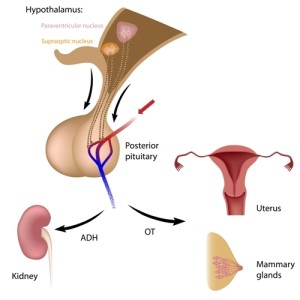ADH (=antidiuretic hormone) and oxytocin are the two major hormones that can get deficient with posterior pituitary disease. These two hormones are constantly being produced in the hypothalamus and secreted along special nerve pathways (thanks to www.biology.arizona.edu for this image) to the posterior pituitary gland where they are stored in the posterior pituitary gland cells.
Deficiency of ADH (=also called “vasopressin”) has been described under “diabetes insipidus”. There is no posterior lobe tumor known that would produce oxytocin, nor is there a known deficiency condition regarding oxytocin.
However, clinically in obstetrics it is common to have patients with prolonged labor and delivery with a subsequent postpartum hemorrhage. At such times there is no time for studies, as this is an emergency situation, however, some of these cases likely are due to a lack of natural oxytocin leading to a uterus that does not contract adequately. This can be treated with oxytocin injections or infusions after retained placental issue has been removed.
Also, some cases of labor where uterine contractions fade in a prolonged delivery may be due to inadequate oxytocin production in a woman in labor who is exhausted. Here careful labor augmentation with a smaller amount of Syntocinon (=brand name for oxytocin) can lead to normalization of the remaining delivery, provided there are no other underlying problems. For an overdue pregnancy at 42 weeks or more (normal is 38 to 42 weeks) an induction with a “Syntocinon drip” can be a godsent.
References:
1. B. Sears: “The age-free zone”. Regan Books, Harper Collins, 2000.
2. R.A. Vogel: Clin Cardiol 20(1997): 426-432.
3. The Merck Manual, 7th edition, by M. H. Beers et al., Whitehouse Station, N.J., 1999. Chapter 8: Thyroid disorders.
4. The Merck Manual, 7th edition, by M. H. Beers et al., Whitehouse Station, N.J., 1999. Chapter 7:Pituitary disorders.
5. J Levron et al.: Fertil Steril 2000 Nov;74(5):925-929.
6. AJ Patwardhan et. al.: Neurology 2000 Jun 27;54(12):2218-2223.
7. ME Flett et al.: Br J Surg 1999 Oct;86(10):1280-1283.
8. The Merck Manual, 7th edition, by M. H. Beers et al., Whitehouse Station, N.J., 1999. Chapter 261: Congenital anomalies.
9. AC Hackney : Curr Pharm Des 2001 Mar;7(4):261-273.
10. JA Tash et al. : Urology 2000 Oct 1;56(4):669.
11. D Prandstraller et al.: Pediatr Cardiol 1999 Mar-Apr;20(2):108-112.
12. B. Sears: “Zone perfect meals in minutes”. Regan Books, Harper Collins, 1997.
13. J Bain: Can Fam Physician 2001 Jan;47:91-97.
14. Ferri: Ferri’s Clinical Advisor: Instant Diagnosis and Treatment, 2004 ed., Copyright © 2004 Mosby, Inc.
15. Rakel: Conn’s Current Therapy 2004, 56th ed., Copyright © 2004 Elsevier







